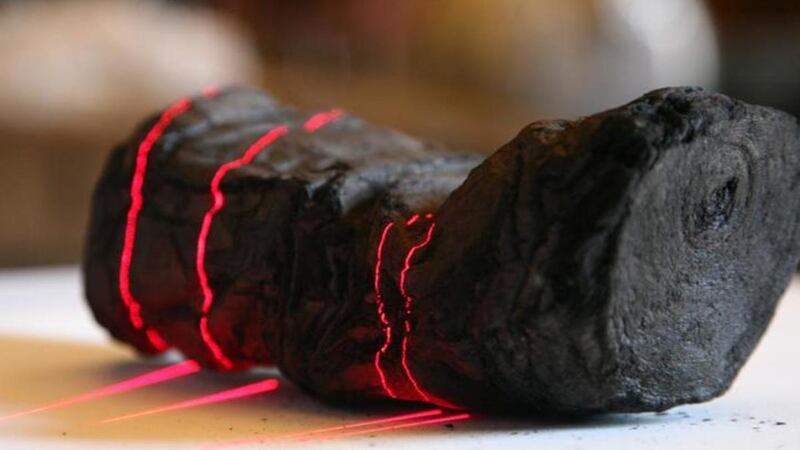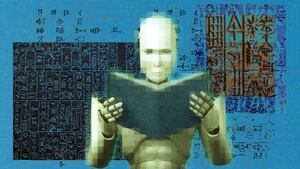This month, a trio of computer scientists won the Vesuvius Challenge, a competition to use artificial intelligence to reveal four passages of ancient Greek encased for 2,000 years inside a charred scroll. The artifact was found at Herculaneum, a Roman resort town destroyed by the eruption of Mount Vesuvius in 79 A.D..
This “kind of thing that happens every half century or so,” Richard Janko, a professor of classics at the University of Michigan and one of the judges for the competition, told The Daily Beast. Federica Nicolardi, a papyrologist at the University of Naples Federico II in Italy and a fellow judge, told The Daily Beast that the discovery “could be a huge revolution.”
The technology enables archeologists to potentially “see” inside ancient burnt, sodden, and sealed texts. This includes works of classical antiquity, to hidden writing wrapped up in Egyptian mummies, to books burned in World War II, to the many thousands of fragments of texts found in the Dead Sea that could shed new light on the early history of Christianity.
Perfectly preserved by the volcanic eruption, the town is a kind of in-between space where destruction and conservation go hand-in-hand, Nicolardi said. Archeologists have spent centuries excavating sections of the Herculaneum, including the Villa Dei Papiri, from which about 1,800 cataloged fragments or entire scrolls have been recovered.

Herculaneum scroll with red laser lines being scanned at Institut de France by Brent Seales and his team.
EduceLab.However, the scrolls are incredibly fragile. After all, they’re ancient on top of being burned and charred. As a result, several hundred have been ruined by people trying to unroll them manually or using machines. Due to this, there are only a few hundred left that can potentially be read.
That’s the genesis behind the competition: If the team could crack one of them open digitally, then digitally unwrapping anything else would be easy by comparison.
The contest was backed by ex-GitHub CEO Nat Friedman and Y Combinator partner Daniel Gross who offered a $1 million grand prize to the person or team who could generate at least four columns of readable digital text from scans of a Herculaneum scroll by the end of 2023. The winning team was made up of AI engineers named Youssef Nader, Julian Schillinger, and Luke Farritor who were able to recover 15 columns of text from the papyrus, revealing the ancient Greek lines laid out like a newspaper.
The process they used was originally developed by Brent Seales, a computer scientist at the University of Kentucky who has spent 20 years using technology to digitally analyze and restore ancient texts. The tool, called the Volume Cartographer, uses AI to digitally unwrap the layers of a single burnt papyrus scroll that Seales’ team had made 3D scans of.
But the challenge isn’t over yet. The team’s winning entry reveals just five percent of a single scroll. For 2024, Friedman, Gross, and Seales have a new competition: Unroll a whole scroll to win a $100,000 prize. Eventually, they want to digitally unwrap all the surviving and intact Herculaneum scrolls.
If they achieve that, then the library could reveal new information about some of the most famous figures in history such as Aristotle and Archimedes. Janko added that the text the competition has revealed may have been written by Philodemus, an Epicurean philosopher and teacher of the famous Roman poet, Virgil.
But first, more of the scroll needs to be segmented, which is the technical term for unraveling the digital layers of papyrus. Then there’s a matter of translating what they find, which can be a herculean task—potentially made less so with the help of AI. “Reading the papyrus is not just a matter of recognizing letters,” Nicolardi said. “It is more a matter of understanding the text.”
The Rise of the AI Archaeologist
Using computers and scanning techniques in archeology is not new. The first mummy to be analyzed using X-ray occurred in 1896. Such technology has long been used to uncover archeological discoveries since then for more than a century. Before Seales’ digital unwrapping tool, though, Janko estimated it would have taken at least 500 years to go through the Herculaneum scrolls.
Seales has solved the problem of unrolling the fragile scrolls by using synchrotron scanning, which involves shooting a powerful particle accelerator’s laser at a scroll and to create high-fidelity X-rays that show all its layers. From there, each layer has to be picked out and segmented. The inner layers are the easiest to peel apart, Seales said.
“That has been incredibly gratifying to see this youthful brain trust of people, who really understand AI, to see them being excited about classics,” Seales said.
While this protocol has only been used on these scrolls so far, it has a wide range of archeological applications. For example, Seales has used the technology to digitally unwrap some of the Dead Sea Scrolls, as well as a copy of the Book of Leviticus recovered from a burnt synagogue at En Gedi, Israel dating to the third or fourth century C.E..
He also plans to scan and decipher a still-sealed Egyptian papyrus scroll that is housed in the Smithsonian Collection. This artifact, bandaged in linen and sealed with wax marked with the symbol of Amenhotep III dates to about 1400 B.C.E. and has never been opened.
Seales has also used the technique to see inside burned medieval books recovered from the wreckage of Chartres, a French town near Paris that was largely destroyed in World War II during an Allied bombing campaign in 1944.
Another potential treasure trove could be lurking deep in the Black Sea, Janko said. There are at least 67 ancient shipwrecks on the seabed that—because the water is devoid of oxygen below 140 meters depth or so—have never decayed, freezing them and their cargo in time. Amongst the potential treasure trove is a box of books and scrolls that could hold even more ancient historical secrets. It might now be possible to retrieve and see inside those papyri thanks to this technological advance, Janko said.
It’s not just the classics that may see a renaissance in discoveries: There is also the possibility to apply the technology to old film reels and negatives that have become corroded and unable to be developed or read using traditional methods, Seales said.
For now, though, researchers are still working on a translation they feel confident in for the 15 columns they have so far. This is a process that even the most hubristic Silicon Valley evangelist can’t speed up, Nicolardi explained.“I think there is a moment for this kind of speedy work and there is another moment when you have to stop a little bit and think about it and reflect,” she said. The scroll itself makes much the same point. Nicolardi notes that its last sentence roughly translates to: “May the truth be always evident to us.”







